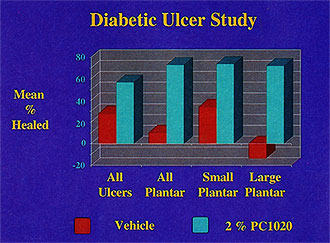Copper Helps Heal Wounds
ProCyte Corporation, Kirkland, Washington, is developing copper-bearing compounds that help some of the body's enzyme systems do their jobs, which includes tissue repair and healing. Some of the dietary copper ingested in a proper diet is taken up by the body to fight infections and to heal wounds and severe burns. When the immune system breaks down, a problem for many millions, especially diabetics and others with impaired immune systems, infections persist and wounds take too long to heal or don't heal at all. For these people, augmented delivery of essential copper at the cellular level is the answer.
 This chart shows the percent increase in the amount of healing of various types of diabetic skin ulcers for patients using ProCyte's Iamin gel (PC1020), a copper compound, vs. a placebo (Vehicle). The study covered an eight-week period.
This chart shows the percent increase in the amount of healing of various types of diabetic skin ulcers for patients using ProCyte's Iamin gel (PC1020), a copper compound, vs. a placebo (Vehicle). The study covered an eight-week period. Image courtesy of ProCyte Corporation.
Founded in 1986, ProCyte is hoping its first copper-bearing therapeutic product will receive final approval by late 1995 or early 1996, according to Vice President Karen L. Hedine. One of its peptide-copper compounds, Iamin® gel, is already in the third and last phase of the complex approval process required by t he U.S. Food and Drug Administration.
Dr. Gerit Mulder, founder of the Wound Healing Institute, Aurora, Colorado, has been testing ProCyte's Iamin gel to treat diabetic plantar ulcers. These chronic wounds are particularly difficult to treat. Often, they become gangrenous, requiring lower-leg amputations - some 60,000 a year in the U.S. alone.
Other chronic wounds include pressure ulcers in the bedridden and venous stasis ulcers on those with poor circulation. At present, according to Hedine, there is no federally approved drug to treat these nonhealing wounds, which are estimated to afflict some 4.5 million Americans.
According to Mulder, a podiatrist, once-a-day applications of Iamin gel have healed some diabetic ulcers in six to eight weeks. This is "definitely faster" than current non-drug treatments, he claims, and therefore should prove more cost effective than other approaches, some of which take as long as 20 weeks.
The gel can be applied externally by patients at home. This is a big advantage over one of the alternative treatments, skin grafts, which require costly hospitalization and the efforts of specialists, says Mulder.
Iamin gel has also been tested in laboratory models (rats with steroid-induced wounds). Dr. H. Paul Ehrlich, a biologist, studied the gel while associated with Harvard Medical School - he's now with the Hershey Medical Center, Hershey, Pennsylvania. The gel had "positive effects" compared to current approaches, such as application of growth hormones.
Other Applications
The topically applied copper-bearing compounds have also been tested on inflammatory bowel disease, which includes colitis and Crohn's Disease. A new copper compound may even have a role in countering HIV, the precursor to AIDS, according to ProCyte's Hedine. Still other potential applications are hair growth and hair loss prevention. These are now under study at the University of Wisconsin, Madison, by Dr. Hideo Uno, and at the Philip Kingsley Trichological Centre, London, England.
Copper also plays a healing role in treatment of severe burns, according to Dr. John Cunningham, Shriners Burns Institute, Boston. To make sure that his patients, all children, receive enough copper, it is delivered intravenously in combination with other necessary trace minerals.
Various applications for ProCyte's copper-bearing gel are also under study at 30 medical centers in the U.S. and also in France, Japan and the United Kingdom.
ProCyte: 206/820-4548.
Also in this Issue:
- Critical Listeners Crave Copper Cable
- Copper Protects Motors Chemical Surprise Improves Lubricants
- Copper Helps Heal Wounds
- Copper Has Key Role in Healthy Hearts
- Protecting Bronze Against Pollutants
